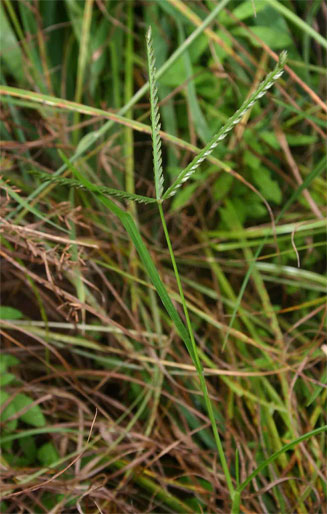Eleusine coracana
(African
finger millet, Ragi)
osgras [Afrikaans]; uphoko [Zulu; mpogo [Pedi]; majolothi [Ndabele]; mufhoho
[Venda] Life
> eukaryotes >
Archaeoplastida >
Chloroplastida
>
Charophyta > Streptophytina > Plantae (land plants)
> Tracheophyta (vascular plants) > Euphyllophyta > Lignophyta (woody plants)
> Spermatophyta (seed plants) > Angiospermae (flowering
plants) > Monocotyledons > Order: Poales
> Family: Poaceae
 |
|
|
Eleusine coracana, Old hotel building site,
near Castleburn, Vumba, Zimbabwe. [photo Petra Ballings ©,
Flora
of Zimbabwe] |
|
This species was domesticated in Africa from the wild form
Eleusine africana more that 5000 years ago (this dating is based on the
seeds found in a 5000 year old archaeological site in Ethiopia). In southern
Africa it has been cultivated since the Iron Age. See
Flora of Zimbabwe.
Within southern Africa, African finger millet is favoured
as a source of malt for brewing of beer because of the sweetness it gives the
malt. Further north in Africa it is used more commonly as a source of food such
as porridge (e.g. in Zambia and Malawi). Plants are harvested by hand using a
knife and are then stored whole until needed. After threshing (beating out of
the seeds) and winnowing (separating off of the chaff [i.e. outer husks] using
the wind), the seeds are ground between stones to produce flour or germinated to
produce malt.
Ecological relationships
Acetobacter diazotrophicus
Bacteria
Acid-producing, nitrogen-fixing bacteria found in roots, rhizosphere and stems. |
|
Publications
-
van Wyk, B.-E. & Gericke, N. 2000. People's
Plants. A Guide to Useful Plants of Southern Africa. Briza Publications,
Pretoria.
|
